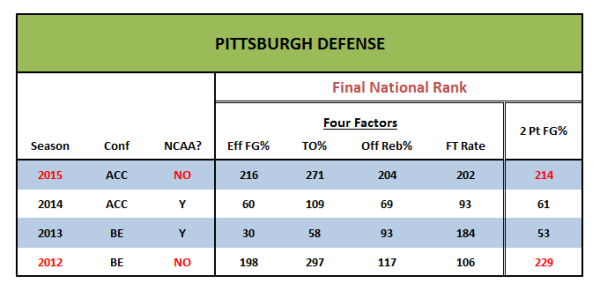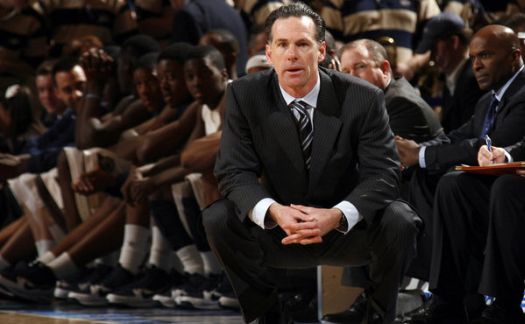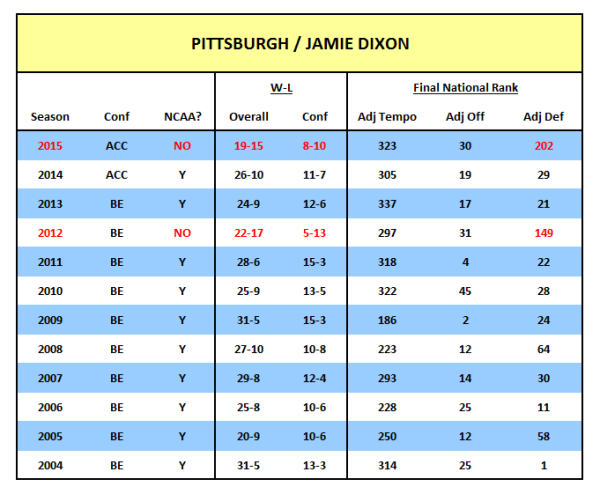ACC Preview: Pittsburgh’s Burning Question
Posted by Brad Jenkins (@bradjenk) on October 28th, 2015This team preview is part of the RTC ACC microsite’s preseason coverage.
Can Pittsburgh’s defense improve enough to get Jamie Dixon back to the NCAA Tournament?
The tempo-based statistics revolution has shed new light on the brilliance of many programs across the country, but perhaps none more so than Pittsburgh during the 12-year Jamie Dixon era. The Panthers have won a lot of games under Dixon but never scored a ton of points — characteristics that were traditionally viewed as an indication of a poor offensive team that plays excellent defense. That was the consensus perception about Dixon’s program for years, and even now, the majority of casual basketball fans might still believe that Pitt’s real strength has been its defense. Put simply, however, that is not the case, and we have the statistics to prove it.
This misconception about Pittsburgh is of course related to how slowly the Panthers have played during Dixon’s tenure. Over the last 12 seasons, only one Pitt team finished among the top 200 nationally in adjusted tempo. During the same span, eight Panthers’ squads have finished among the bottom 50 in pace, including each of the last six seasons. With such a well-established track record of low-possession basketball, it’s not surprising that point totals are going to be misleading when evaluating the Panthers’ effectiveness on both ends.
The table above shows that there have only been three seasons when a Dixon-led Panthers team was better on the defensive end than the offensive one, and none of those instances have occurred in the last five seasons. This isn’t to say that Pittsburgh has failed to field very good defenses – in most seasons it has been relatively skilled at stopping opponents as well. It’s just that the defense has rarely matched the consistently high quality of the offense, as the Panthers have finished among the nation’s best 45 units in every year of Dixon’s coaching career. It’s certainly no coincidence that the Dixon’s two Pitt teams that failed to make the NCAA Tournament were also his two worst defensive squads.
 Digging a little deeper, it’s evident that the main problem in both of those seasons was a feeble two-point field goal defense. While the Panthers were not particularly good at anything on the defensive end in either 2012 or 2015, their stark lack of protection at the rim stands out as the primary issue with those teams. To his credit, Dixon turned things around quickly on the defensive end in 2013; can he replicate that same degree of improvement this time around? The main roster change three years ago was to replace 6’5″ Nasir Robinson with 7’0″ freshman Steven Adams, a 2013 NBA first round pick. Perhaps unsurprisingly, that swap resulted in a significantly improved interior defense, and it appears that getting bigger is again Dixon’s plan for improvement this season. Three transfer centers are now on board, with two of those coming via the graduate transfer route — Rafael Maia (Brown) and Alonzo Nelson-Ododa (Richmond). The third, JuCo transfer Rozelle Nix (6’11”, 300 lbs.) is the biggest and least known quantity of the bunch. Still, none of the three projects to have the dramatic defensive impact that Adams brought to his one year in the program, so it’s no given that the additional size will solve Pitt’s defensive deficiencies.
Digging a little deeper, it’s evident that the main problem in both of those seasons was a feeble two-point field goal defense. While the Panthers were not particularly good at anything on the defensive end in either 2012 or 2015, their stark lack of protection at the rim stands out as the primary issue with those teams. To his credit, Dixon turned things around quickly on the defensive end in 2013; can he replicate that same degree of improvement this time around? The main roster change three years ago was to replace 6’5″ Nasir Robinson with 7’0″ freshman Steven Adams, a 2013 NBA first round pick. Perhaps unsurprisingly, that swap resulted in a significantly improved interior defense, and it appears that getting bigger is again Dixon’s plan for improvement this season. Three transfer centers are now on board, with two of those coming via the graduate transfer route — Rafael Maia (Brown) and Alonzo Nelson-Ododa (Richmond). The third, JuCo transfer Rozelle Nix (6’11”, 300 lbs.) is the biggest and least known quantity of the bunch. Still, none of the three projects to have the dramatic defensive impact that Adams brought to his one year in the program, so it’s no given that the additional size will solve Pitt’s defensive deficiencies.
If some combination of the three new big men can take most of the minutes at the center spot, it would free up forwards Michael Young and Jamal Artis to slide into their more comfortable forward positions. Three other returnees — Sheldon Jeter, Chris Jones, and sophomore Cameron Johnson — provide additional depth at both wing positions. The strength of this season’s team, though, may be in the backcourt. College coaches love veteran point guards, and Dixon has one in senior James Robinson. Though not the type of player to dominate a game offensively, Robinson takes care of the ball, makes good decisions, and provides steady leadership. He will get support from a trio of newcomers, including another graduate transfer in Sterling Smith (Coppin State). Smith shot the ball well from deep (41.8% from three-point range) and scored 13.9 points per game in the MEAC last season. Freshman Damon Wilson and JuCo transfer Jonathan Milligan will also look to get into the backcourt mix.
Even with six newcomers, these Panthers are a veteran group, with 10 upperclassmen on the roster. For Dixon, he hopes that the influx of experienced size will have a huge positive impact on last year’s subpar interior defense. If that isn’t the answer, however, recent history suggests that Pittsburgh will be at risk of missing the NCAA Tournament for the third time in five years. Avoiding the injury bug that has plagued them in recent years (as well as this offseason) would also be immensely helpful. Since the program left the Big East for the ACC three years ago, Dixon expected his program to join and stay among the conference elite. This will be a pivotal year for his program to show that such a goal is still realistic.












































